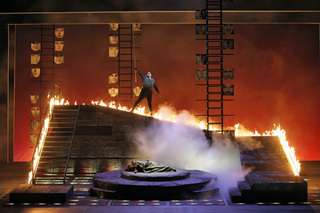|
Back
What Price Obedience ? San Francisco
War Memorial Opera House
06/10/2010 - & June 13, 19, 22, 25*, 30, 2010
Richard Wagner: Die Walküre
Nina Stemme (Brünnhilde), Mark Delavan (Wotan), Eva-Maria Westbroek (Sieglinde), Christopher Ventris (Siegmund), Janina Baechle (Fricka), Raymond Aceto (Hunding), Molly Fillmore (Ortlinde), Suzanne Hendrix (Schwertleite), Daveda Karanas (Waltraute), Wendy Bryn Hamer (Gerhilde), Tamara Wapinsky (Helmwige), Maya Lahyani (Siegrune), Pamela Dillard (Grimgerde), Priti Gandhi (Rossweise)
San Francisco Opera Orchestra, Donald Runnicles (conductor)
Francesca Zambello (director), Michael Yeargan (set designer), Mark McCullough (lighting designer), Lawrence Pech (choreographer), Catherine Zuber (costumes), Jan Hartley (production designer)

(© Cory Weaver)
The San Francisco Opera’s June 25 performance of Die Walküre was an extraordinary offering of theatricality at its best. Take one operatic warhorse, add a first-class opera company, place a powerful yet disciplined orchestra in the pit, import a widely renowned opera director, set designer, and lighting expert, and then select singers of near-peerless ability. Add a dash of that ineffable quality that creates artistry from virtuosity, and voilà! A star production is the delicious result.
This production opened amid much fanfare, and ultimately, well deserved. Taking on any of Wagner’s operas, especially one of those within Der Ring des Nibelungen, is an ambitious proposition for any of the great companies, and this opera company is of a caliber to meet the challenge. Indeed, this production may well, with the benefit of hindsight, be considered one of the best interpretations of the past 50 years. The set design was a commentary on the 20th century, yet remained true to its mythological roots. Lighting not only provided exemplary ambience, but was cleverly incorporated into the staging as well.
Sopranos Nina Stemme as Brünnhilde and Eva-Maria Westbroek as Sieglinde crafted magnificent performances. Both women seem to have been destined for Wagner. Their singing was unforced, voices were true, and projection was beautifully balanced. They acted their roles convincingly and, as any virtuosic performer will do, disguised weaknesses in the libretto with a confidence many performers would envy. Tenor Christopher Ventris, as Siegmund, came very close to Westbroek’s artistry. Wotan, portrayed by bass-baritone Mark Delavan, was stalwart as he tackled this difficult role; what was occasionally missing in projection was compensated for by solid stage presence. Janina Baechle’s mezzo-soprano Fricka delivered stage presence in spades, as she and Wotan sparred and Fricka ultimately triumphed. Baechle injected a subtle humor into the scene from which it clearly profited. Bass Raymond Aceto played Hunding with a savage brutality, contrasting nicely with the lovers’ sweet passion. The remaining eight Valkyries, rather than taking their roles for granted, delivered an enthusiastic and individualistic presentation that is lacking in most interpretations and was, consequently, welcomed and refreshing
Donald Runnicles conducted the San Francisco Opera with verve and panache, creating an exuberant foundation that must only have inspired the singers to deliver their best efforts. Here was synergy of a high degree, seldom experienced by participants and viewers alike, especially given the technical difficulty of Wagner and the demands made upon all of the artists to be at the pinnacle of their ability.
There was some unfortunate choreography, especially in the third act when the Valkyries arrive via parachute with their dead heroes. The staging of their arrival was delicious, the singing superb, but at times the women moved about the in an ungainly rather than heroic manner. Choreography in Wagner has always been an awkward issue, but there are times when it is appropriate to challenge convention. The costuming could perhaps have been designed to be more flattering to generous physiques. One wishes to see bodies move gracefully to such a luscious musical score. Possibly this aspect of the production is the easiest to improve, and is the only element preventing it from being unreservedly considered one of just a few definitive interpretations.
A delightful surprise in the third act was the spectacle of the "dogs of war," an offering happening so rapidly that only the attentive would witness two large dogs bounding across the stage as the inevitable battle between the characters was about to begin. These cameo appearances may be a harbinger of future starring roles for such talented canines. All whimsy aside, clearly the entire project was an effort of immense dedication and love both for operatic artistry and for its appreciative audience, requiring much talent, stamina and steely discipline among all involved in this performance.
This production of Die Walküre is a significant addition to its performance history, and one of which the San Francisco Opera should be justifiably proud, surpassing as it did its own high standards. It is becoming increasingly difficult for a major opera company to finance an entire Ring Cycle, and, in fact, this is a co-production with the Washington National Opera. Given the enormous stress of live performance, epic-length projects, coordination and funding, the excellence of this particular production is quite astounding. One departs the theatre wondering if one is witnessing the Twilight of Artistic Production as it is traditionally experienced.
Claudia K. Nichols
|